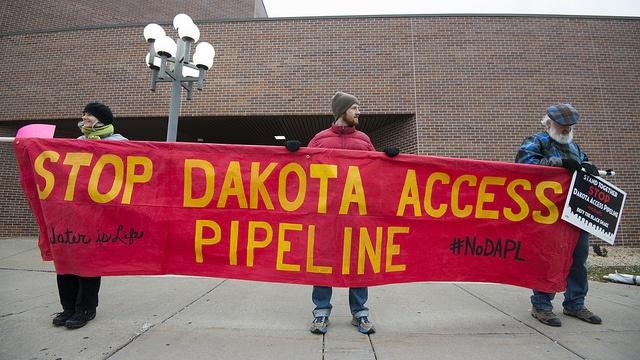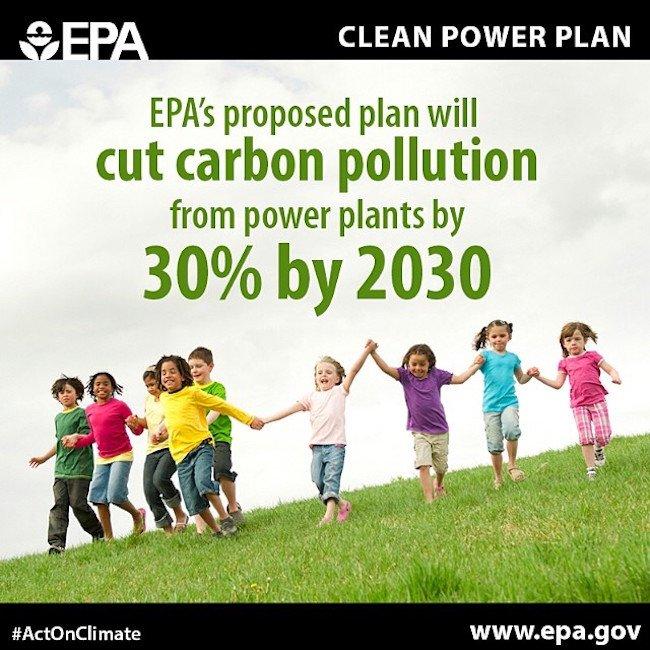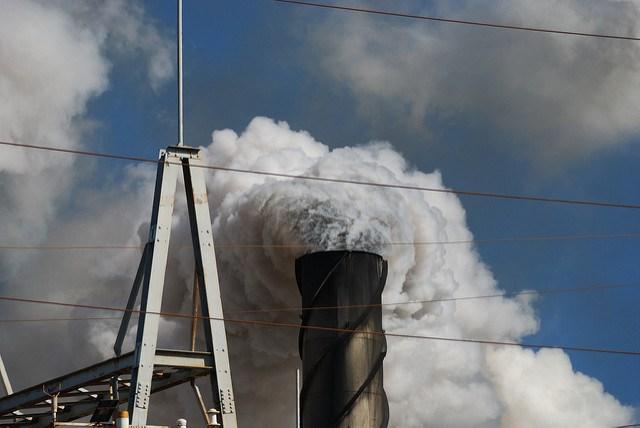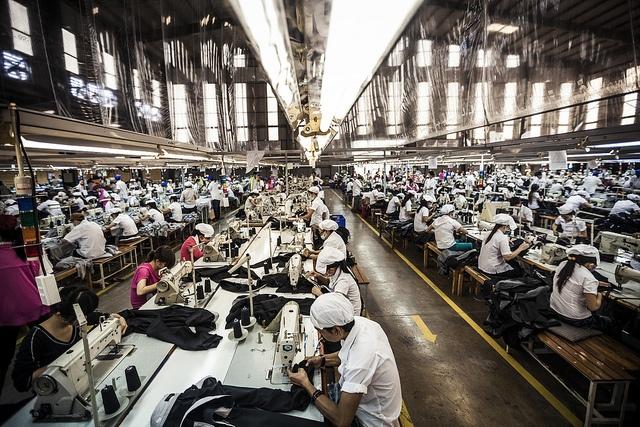The Dakota Access Pipeline Fight Isn't Over


A federal judge who refused to halt the Dakota Access Pipeline’s controversial route under the Missouri River is now siding with the Obama administration’s efforts to block its current route, which the Army Corps of Engineers agreed may present risk to local water sources.
On Friday, U.S. Judge James Boasberg turned down a request by Energy Transfer Partners, the company building the pipeline, to “force” the federal government to expedite the project and let crews drill under the river.
Instead, Boasberg promised to review the case next year and gave Energy Transfer and the Justice Department until Jan. 31 to file petitions with the court.
The denial is the latest blow to the developer’s effort to complete the last leg of a 1,200-mile pipeline that would transport heavy Bakken crude from North Dakota to Patoka, Illinois.
The Obama administration’s surprise decision to turn down the route under the Missouri River brought jubilant responses not only from the Standing Rock Sioux Tribe and the cadre of protesters settling at a local encampment, but also from indigenous supporters across the world.
The DAPL protests are arguably the biggest and most vocal Native American protests in U.S. history. It has also become a symbol for indigenous tribes across the world who are struggling to solidify their own rights to local natural resources. Earlier this fall the Maya Indians of Guatemala traveled to Standing Rock to express their support for the Sioux tribe’s concerns about vital water resources.
The fate of the DAPL under a Trump administration
But does the Army Corps' decision really ensure that the Standing Rock Sioux's water and burial sites will be protected?
Even though Standing Rock Sioux Chairman David Archambault II called for protesters to go home, environmental organizations are sounding alarm that an incoming Trump administration could swiftly reverse the decision and award Energy Transfer Partners the right to drill under the Missouri River.
"The Trump administration could easily approve the project early next year," wrote supporters of Sacred Stone Camp, a website representing a grassroots movement opposing the DAPL-Missouri River crossing.
The organization asserts that the U.S. Army Corps of Engineers never really agreed to do a full environmental impact statement of the entire DAPL route -- even after the Corps announced it would need to review alternative options for DAPL's path. But the Corps said it will conduct a more thorough impact statement to help determine how to complete the pipeline.
But a pro-pipeline stance by the Trump administration doesn't necessarily mean Energy Transfer Partners will get their preferred route back, argues EarthJustice, which is providing Standing Rock's legal defense.
"Reversing this decision would be arbitrary, capricious and unlawful, and we would challenge it in court," EarthJustice insisted. "There are important issues on the table concerning tribal treaty rights and environmental justice that the Corps decided need a full review."
“The question on everyone’s mind is what happens in seven weeks,” said Jan Hasselman, a lawyer with the environmental organization. “If Trump reverses this decision, we’ll see them in court.”
Still, there are factors that pipeline proponents say should be taken into consideration in the future review. And there are others that could influence the outcome of a Trump-backed decision.
This isn't the first pipeline
Proponents point out that the Missouri River has been a crossing route for pipelines before. In fact, says the Standing Rock Fact Checker (SRFC), the proposed pipeline was designed to cross Lake Oahe at the same approximate point as a natural gas pipeline that was erected in 1983.
The SRFC is a project of the Midwest Alliance for Infrastructure Now (MAIN), a consortium of businesses that support the Dakota Access Pipeline. According to MAIN, the Northern Border Pipeline transports about 2 million cubic feet of natural gas each day to lllinois and Indiana using a crossing underneath Lake Oahe.
But natural gas isn't Bakken crude oil. While both substances have proved to be disastrous for drinking water sources, recent crude oil pipeline spills demonstrated even greater challenges in adverse or changing weather.
A crude oil spill under the Yellowstone River, which we reported on in January 2015, has become the test case for what happens when crude oil leaks under a major waterway -- and the unknown factors that contribute to environmental and drinking water degradation.
Crude oil pipeline leaks aren't rare
In June 2015, after a crude oil leak in Santa Barbara, California, High Country News published a map of crude oil leaks in North America. More than 200 incidents were reported in a five-year period, most from corrosion or defective seals or fittings.
Crude oil leaks continue to be a major concern, especially in the Midwest, where communities have expressed concern about the potential risk to wetlands and drinking water resources from heavy oil.
Native American sovereignty and rights
Last week, as ETP was in court appealing the Obama administration’s decision, another appeal was taking shape, this time before the Organization of American States.
On Friday, three U.S. tribes -- the Standing Rock Sioux, the Yankton Sioux and the Cheyenne River Sioux -- testified before the Inter-American Commission on Human Rights concerning the recent impacts of the DAPL project.
According to the filling, the tribes asked the commission to urge the U.S. government to “adopt precautionary measures to prevent irreparable harm to the Tribes, their members, and others resulting from the ongoing and imminent construction of the Dakota Access Pipeline, and from the harassment and violence being perpetrated against people gathered in prayer and protest in opposition to DAPL.”
They also maintain that the U.S. Army Corps of Engineers, under the U.S. Army, failed to assess and take precautions to protect against environmental and social impacts from the project, such as the loss of burial sites and artifacts normally protected by federal law.
The tribes also maintain that the steps that were taken by state and county agencies against protesters and water protectors raise “grave human rights concerns surrounding threats, harassment and injury sustained by people peacefully praying and protesting in defense of the waters and the Tribes’ rights.”
With the Trump administration due to take office in less than a month, it is unclear what geographic route, if any, the DAPL will take next year. But for now, both sides seem to be digging in for the long, hard winter fight.
Image credit: Flickr/Fibonacci Blue
EPA Under the Trump Administration: Down, Not Out


1. The EPA will go down swinging
Railing against the burden of EPA regulation on U.S. business has been the low-hanging fruit of Republican office-seekers for a generation. However, in an long form interview with Vox last week, Harvard law professor Jody Freeman makes the point that the Trump administration is going to have a tough time actually harvesting that fruit. That's partly because the EPA and other government agencies operate on a legal platform that can't be changed on a whim. If the Trump administration tries to skip steps and rush rule changes through, environmental organizations and other stakeholders can and will litigate on procedural rules. That legal process can drag on for years. Freeman argues that the courts, even conservative ones, are not friendly to rule-breakers. She provides several cautionary tales from the George W. Bush administration, including this one:" … The Bush administration also came out and said they would reject the Clinton administration’s arsenic standard for drinking water, and that proved to be a political disaster for them — because, you know, the public doesn’t like to be poisoned. And that was also litigated, and [after eight years] the Bush administration ended up sticking to the Clinton standard."A Republican-controlled Congress could try to legislate changes in the laws governing the EPA's mission, if they are willing to let Democrats capitalize on the negative publicity that follows. Based on the cabinet picks so far, negative publicity does not seem to have much of an effect on the Trump administration, let alone Trump himself. However, members of Congress are far more exposed. And they are already facing a growing fire as the Republican plans for Social Security and Medicare come to light. Keep in mind that President-elect Trump lost the popular vote by a number closing in on 3 million votes, and you can see why Republican legislators would want to choose their battles carefully. It's quite possible that the destruction of the EPA by legislative action could take a back seat, at least temporarily. On the other hand, Freeman describes a number of actions the Trump administration could take to stop or roll back EPA activity, without necessarily provoking court battles (do read the full article for details). These can be quite effective:
"There are a lot of ways to slow down implementation and to try to minimize enforcement. Everyone talks about the Reagan administration as a good example of the EPA being 'dismantled from within' — by slow-walking regulations, by slow-walking enforcement."However, these options still involve a timeline and some degree of preparation, as well as pushback from Democrats and other stakeholders, including the agency's own staff. The bottom line is that the Trump administration will press for swift action against the EPA, but the result will be a slow, messy battle.
2. Veterans are going to bat for the environment
Outside of the courtroom battle, the Trump administration is facing a wave of environmental action that is riding on the success of two important fights. Those two wins -- the suspension of both the Keystone XL tar sands oil pipeline and the Dakota Access pipeline -- have primed the pump for future actions. In another less-publicized but significant victory, in May the U.S. Army Corps of Engineers refused to issue a permit for the proposed Pacific Gateway coal export terminal, citing tribal concerns and agreements. One key development is the participation of veterans in the Dakota protests. Thousands organized to join the protesters as a group under the banner of Veterans Stand for Standing Rock, an action that quickly caught the media eye. Wesley Clark Jr., whose father is former NATO commander Wesley Clark, is one of the veterans who organized Veterans Stand for Standing Rock. Clark said the group is already anticipating lending its support to other causes, possibly starting with the water crisis in Flint, Michigan:"We don't know when we are going to be there but we will be heading to Flint," Clark Jr. told Jiquanda Johnson of Michigan media outlet MLive.com. "This problem is all over the county. It's got to be more than veterans. People have been treated wrong in this county for a long time."At least one other veterans organization, the similarly named Veterans for Standing Rock, was also active in the Dakota protests. Veterans' support for environmental action is a new twist that attracts the media spotlight, and that could help build broad public interest in preserving the EPA's health and safety mission. The Trump administration may not feel inclined to listen, but legislators will likely hear plenty from their constituents.
3. U.S. business is already invested in clean power
The Clean Power Plan and the Paris climate agreement are two main targets for the incoming Trump administration. But U.S. companies have already begun pivoting to renewable energy, and that trend is not likely to slow significantly. In the Vox interview, Freeman listed several legal obstacles that will slow the Trump administration from rolling back the Clean Power Plan outright, or removing the U.S. from the Paris agreement. The interest of U.S. businesses in renewable energy will be another major stumbling block. The business sector is investing in renewable energy at a record setting pace, helped along by several organized efforts. One is the Rocky Mountain Institute, which offers a streamlined renewable energy toolkit through its Business Renewables Center. Another is the American Act on Business Climate Pledge, representing voluntary renewable energy commitments by dozens of leading companies. The EPA also provides support and publicity to leading clean energy buyers through its Green Power Partnership. That's going to be interesting, considering the growing connection between the Trump administration and Goldman Sachs. The investment firm is a solidly in the clean energy camp, and this year it was one of 16 Green Power Partners awarded for their role in reducing greenhouse gases.4. U.S. states already love clean(er) power
The majority of U.S. states have begun to follow the global trend of decoupling economic growth from carbon emissions, as illustrated by a recent report from the Brookings Institution. According to the report, from 2000 to 2014, 33 states and the District of Columbia have seen their emissions drop by 12 percent as a group, while their economies grew by 22 percent. Our friends over at Green Tech Media provided a handy summary of the report. Brookings gives primary credit for the global carbon decoupling to the switch from natural gas to coal. And that creates an interesting dilemma for the Trump administration. To the extent that market forces are behind the switch to natural gas, Trump is going to have a tough time getting utilities in those states to return to coal. Meanwhile, the pipeline protests show that the public's tolerance for oil and gas infrastructure has reached a limit. Oklahoma, for example, recently ordered an emergency shutdown of disposal wells for oil and gas wastewater, which have been linked to hundreds of earthquakes. To sum up, Trump's threat to shut down the EPA is not just another empty campaign promise. However, his administration will be going up against some significant pushback, and his efforts may prove to be a Pyrrhic victory. Image: US EPA via storify.com.What Trump’s Presidency Could Mean for Business


Editor's Note: This article originally appeared in Medium.
By Paige Morrow It is difficult to predict exactly what Donald Trump will do for business because his policy platform has been vaguely defined from the beginning and continues to shift as he decides on his leadership transition team. The president-elect won on a divisive message that promises to put America first and turn back the tide of globalization to ensure America's greatness. What is clear is that he will have difficulty delivering on his promise of decent jobs for working and middle-class Americans, particularly those affected by the transformation of the American economy as manufacturing and other factory-based jobs are shifted overseas due to the globalization of trade and production. Those jobs have been definitively lost. Although Trump’s political platform is vague, he has repeatedly threatened to end free trade in North America by withdrawing from NAFTA, and stop all negotiations with the EU for a new free trade agreement (TTIP) in order to “bring back jobs." Reopening coal plants or imposing stiff tariffs on cars that have been produced in Mexican plants to replace automotive plants in the U.S. might forestall but will not reverse the trend. In the days following the election, much was written about the connection between globalization and marginalization. Trump is perceived to have won a significant part of the working-class vote in Rust Belt states on the basis of his promise to win back jobs and tear up NAFTA. In the context of economic globalization where transnational organizations are seen as the guarantors of the world order, a large part of the U.S. lower and middle classes have felt excluded from their benefits. It has been said that Trump’s victory was a vote against the establishment, which opponent Hillary Clinton represented after 40 years in politics. Similarly, many said this backlash against “politics as usual” was also seen in the vote for Bernie Sanders or the victory of Brexit in the U.K. At the same time, Trump also pledged a number of pro-Wall Street reforms, including repealing Dodd-Frank, which was enacted after the 2008 financial crisis. However, banks have spent significant resources to comply with its provisions, so they are unlikely to wish it to be overturned but rather have some of the more constraining provisions deleted, such as the Volcker Rule.How will this new era of politics affect economics and corporate governance?
But he cannot undo globalization without becoming isolationist and destroying the economy. If Trump really wants to “make America great,” he should start by making it fair. Tom Wilson, chairman and chief executive officer of Allstate Corp. and vice chairman of the U.S. Chamber of Commerce, recently wrote: “The emphasis on profits has widened the trust gap between corporations and society, resulting in an adversarial relationship between the private and public sectors. Let me be clear: Shareholders must get a good return, but at the same time corporations must work to be a force for good in society." One of the reasons why many Americans felt excluded is that, since the 1970s, financial markets have taken a central role and were used as the only mechanism for growth. We have reached a point where only 15 percent of the money flowing from financial institutions actually makes its way into business investment. Financial markets have doubled in size and scope, but little of that was transferred to the real economy. At the same time, workers’ salaries have stagnated. Productivity has grown by 72 percent over the last 40 years, but average pay has only risen 9.2 percent (see graph here). This, in turn, is contributing to the pay gap between employees and top executives. Executive pay policies are also at the base of unintended social impacts due to directors’ incentive schemes based on share price, a phenomenon that has driven business to myopically focus on short-term financial returns at the expense of acute societal and environmental impacts. One of the few promises that could provide middle-class jobs is Trump’s plan of investing $1 trillion in infrastructure in the next 10 years via public-private partnerships and private investments through tax incentives. Nevertheless, it is still unclear if his intentions to partly privately fund this investment through tax incentives would work. The project’s criteria also poses concern as private investors are only going to be interested in infrastructure projects that come with revenue streams that can make them profits after the projects are completed. A second proposal that could point to the right direction is to ensure that companies pay taxes, as Nobel laureate in economics Joseph Stiglitz suggested “by lowering the corporate rate for companies that invest and create jobs in America and raising it for those that do not." But Trump’s record of business management is not exactly encouraging as he incorrectly used fiduciary duties as an excuse to justify his efforts “to pay no more tax than legally required." Rather than scapegoating international trade for the failure to create good quality jobs, Trump could focus on addressing the inequality that has increasingly characterized the U.S. since the 1970s, and deal with the concentration of corporate power that has left many industries with effective monopolies. Unfortunately, Trump has promised instead to repeal or amend the Dodd-Frank Act, which aims to prevent another financial crisis. Americans voted to send a message against traditional politics, but their decision might only have supported “business as usual” -- which would only serve to further entrench economic disparity. Business and civil-society communities have a fundamental role in ensuring progress on sustainable development. A good example is the pressure put by 300 big U.S. companies demanding to keep climate change commitments agreed in Paris last year. Similar political platforms have gained strength in Europe, with France and the Netherlands facing elections in the upcoming months. Progressive leaders ought to connect with the social discontent and start acting on it. We need a message that unites and brings benefits to the lower and middle classes by creating a model for inclusive prosperity. For all of the above-mentioned reasons, reviewing the current corporate governance framework is key to enable change and an unmissable opportunity to foster a positive systemic change. Image credit: Flickr/Giuseppe Milo Paige Morrow is head of Brussels Operations at Frank Bold, a purpose-driven law firm. The firm leads the Purpose of the Corporation Project, which invites businesses, academics, policymakers, and civil society to debate the future of publicly traded companies. Connect with us on @purposeofcorp or on our Linkedin Group.Why We Work for Something Greater: 4 Ways to Find Your Company’s Cause


By Jeff Snyder
From the smallest of children to the most powerful of CEOs, we're all dreamers. I dreamt of creating an agency built around people — one that put more good into the world than it took for itself.
But life had an interesting way of making my fantasy feel incredibly petty — by introducing cancer into the equation.
Who was I to dream? My courageous 2-year-old daughter, Kennedy, had just been diagnosed with a spinal cord tumor. She was braving chemo, longing to play outside and just be a kid. My dreams couldn't do anything to help her — or so I thought.
As Kennedy was battling cancer, I became increasingly close with Jay and Liz Scott, who had lost their daughter, Alex, to the battle with cancer. As a baby, Alex was diagnosed with neuroblastoma, and at 4, she started her own lemonade stand to benefit cancer research. This tiny girl created just the sort of company I had in mind. Every day, in spite of her illness, she served customers to make the world a brighter place.
Despite their own personal tragedy, Jay and Liz continued to support their daughter's mission by starting the Alex's Lemonade Stand Foundation. Motivated by their story and fueled by my daughter's resilience in battling cancer, I decided it was time to create the agency I'd dreamt of, and I decided to use it to make a difference for Kennedy and all the children fighting for their lives.
An agency for Kennedy and Alex
Since I founded Inspira in 2008, the Alex's Lemonade Stand Foundation has been a part of it. But as much as we've worked to further Alex's legacy, it's benefitted us even more.
We began as just a few employees serving even fewer clients. It forced us to think about what made us different. Well, beyond years of marketing experience — which any agency can claim — we had this cause.
When seeking clients to launch our business, we found that they gravitated to our mission, and they continue to do so today. But simply being associated with a cause isn't enough. We've embraced it, and it has changed our ethos and the very way we do business. Just as Alex's cause gave her energy to sell lemonade despite her illness, it encourages us to go the extra mile to deliver on client promises.
Business leaders aren’t the only ones who are drawn to a cause. Our mission has brought young, ambitious employees to the door — ones who value fulfillment above a fatter paycheck. Nearly 8 in 10 members of America's largest demographic want to work for a socially-conscious employer, and I'm proud to say we've had plenty sign up to work our stand.
Make lemonade for others
To succeed, a cause can't be plug-and-play. It takes planning. If you want to align your company with a cause, you must match your values and goals to that of an organization doing good.
When determining how best to give back, we asked ourselves four questions:
1. What's our recipe for good?
When you just started out, what were your pie-in-the-sky promises — your founding principles? Find a cause that speaks to your company's values, and you'll set the foundation for a solid partnership.
The ingredients that drove Inspira and Alex's Lemonade Stand together were passion, optimism and a fighting spirit. Much like our agency, the Foundation didn't start with much, but its scrappiness helped it garner awareness and relative success.
In a way, we're both underdog stories. That’s why the partnership works — an organization that knows the proverbial end of the tunnel is far away yet charges toward it just the same. Alex's Lemonade Stand won't defeat childhood cancer overnight — perhaps not even in its founders' lifetimes — but that will never stop it from trying.
2. Can we give more than money?
The reality is that anyone can fundraise or write a check. But unique skills — including event coordination and content creation — can benefit a cause for years to come.
To help Alex's Lemonade Stand, we leveraged our marketing know-how in every which way. Whether it's through tapping into our client network for donations, using our vendor partners to create materials, or just volunteering our time and efforts for Alex's events, we try to do more than just provide monetary support.
And perhaps our biggest contribution is starting the Warriors for a Cure team in support of Alex's Million Mile. Based locally, our team has helped garner hundreds of thousands of dollars in support of the Foundation by creating a movement and amplifying its story.
3. Will the team work the stand?
In her neighborhood, Alex was an unapologetic challenger — a tiny fish in a huge pond. That's what it felt like at Inspira in the early days. Marketing is a cutthroat world, and we're a scrappy little agency from Connecticut. That's why our union works.
Remember that this isn't about you. If your team doesn't see itself reflected in the partner, your efforts will fail, no matter how noble they are. To brew a sweet, successful partnership, choose a cause that resonates throughout the company, not just within your heart.
4. What do we hope to receive in return?
It's okay to think selfishly for a moment. How are you hoping this cause will strengthen your company? A transaction doesn't have to be a bad thing. View it as a promise. Your company will give back, hoping the generosity will instill tenacity in your team or create a culture of camaraderie. I know my team's work with Alex's Lemonade Stand has given us all that and much more.
Upon founding Inspira, I swore I'd repay the world that's given me so much — for Alex, for Kennedy and for all the children fighting terrible diseases. So I challenge you: Be more for yourself, for your employees and for those in need. I can attest that the juice is worth the squeeze.
Image credit: Flickr/RachaelChickswithKnives
Jeff Snyder is the founder and chief inspiration officer at Inspira Marketing Group, an experiential marketing agency headquartered in Norwalk, Connecticut, with offices in New York, Chicago, and San Francisco. With more than 20 years of experience, Snyder leads his agency's growth by focusing on building genuine relationships through client development and audience engagement.
What the U.S. Can Learn from the U.K. About Climate Risk


By Joyce Coffee
As the United States welcomes a new presidential administration, and the District of Columbia becomes what I refer to as the “Red Fed,” I find myself examining U.S. regulations and policies seeking business-friendly opportunities for revamped regulation.
I have studied the European Union’s Water Framework Directive that requires compliance by EU ascension states, and it promises exciting prospects for helping Eastern Europe’s emerging economies prioritize water efficiency as their development quickens. I also perused France’s new law under Article 173 of its “energy transition for green growth” regulation, which requires investors to report on how climate change considerations are incorporated into their portfolios.
Both hold promise as excellent examples for the U.S. In particular, I will be watching the application of Article 173 with interest.
In the meantime, the most intriguing regulation to me is the United Kingdom's Adaptation Reporting Power (ARP). It sprang from country's Climate Change Act of 2008, and the subsequent National Adaptation Program in 2013 reinforced it.
The ARP enables the U.K. government to require organizations (known as “reporting authorities”) that provide public services to prepare climate change adaptation reports detailing how they assess and act on the risks and opportunities from climate change. Therefore, it provides an opportunity to gather evidence on climate risk, organizational capacity and activities to build resilience.
Interestingly, early evaluations of the law note: “The ARP was a catalyst for many organizations to begin formally considering their climate change risks and adaptation responses, including at the Board and Management levels” (see the Government Report for the Adaptation Reporting Power).
Having been involved with creating laws when I worked for the city of Chicago and helped promulgate air, stormwater and invasive species ordinances, I remain a super fan of performance-based regulation versus prescriptive law. I believe it is the lack of a prescription that galvanizes conversations at senior levels. If the law had mandated what industry must do, a smart functionary within the company would have complied. Without that parenting, the functionary creates a variety of crazy ideas across company verticals discussed in the C-suite. How exciting!
In the case of ARP, the U.K. government has categorized its adaptation activity into seven “themes.” Among them: agriculture, forestry, water, energy and transportation infrastructure, for which industry leaders are asked to report.
In a first tranche or ARP rollout, reporting was mandatory for the identified corporations. It now is voluntary. While the report’s form is dictated by statutory guidance (and, smartly, includes sections related to the company’s assessed risk and opportunities from climate change and a related action plan in an Adaptation Report), the specifics of what and how industry must respond is left to the market. This inspires healthy competition to derive solutions that mitigate more risk and seize more opportunity.
Early results of ARP, detailed in the government report Adapting to Climate Change: Ensuring Progress in Key Sectors 2013 Strategy for exercising the Adaptation Reporting Power, suggest it is helping to developing capacity to understand climate risk issues in key infrastructure sectors. Notably, it also helped the U.K. government identify specific areas of research opportunity to share with the scientific community.
The government will review the law every five years, primarily to ensure that the voluntary reporting protocol is producing results and a shift to mandatory reporting is not required.
As the U.S. transitions to a new era of federal governance, the U.K. ARP should top our list for the infrastructure and agricultural agendas.
Image credit: Flickr/wbr_deluz
Joyce Coffee, LEED AP, is president of Climate Resilience Consulting working with leaders to create strategies that protect and enhance markets and livelihoods through adaptation to climate change.
3p Weekend: 12 B Corps Leading Their Industries


With a busy week behind you and the weekend within reach, there’s no shame in taking things a bit easy on Friday afternoon. With this in mind, every Friday TriplePundit will give you a fun, easy read on a topic you care about. So, take a break from those endless email threads, and spend five minutes catching up on the latest trends in sustainability and business.
“If we can harness the latent power of markets ... to a higher purpose than maximizing shareholder value, we can unleash one of the most powerful manmade forces ever created,” Jay Coen Gilbert said at the 2016 Net Impact conference in Philadelphia.
Gilbert co-founded B Lab, the nonprofit behind B Corp certification. As B Corporations, firms commit to a rigorous set of standards. Nearly 2,000 companies (including TriplePundit) are now B Corp certified. An additional 50,000 used the B Impact Assessment, a free tool provided by B Lab, to measure their impact and make improvements.
Those who come away from the assessment as B Corps rank among the highest in their industries for social and environmental sustainability. But what may surprise some in the business community is that B Corps often outshine their peers financially as well. Read on to learn more about 12 B Corps taking their industries by storm.
Fashion and apparel
Patagonia
Outdoor gear label Patagonia has been sustainable from the start. And its green cred helped it grow from a small company to a fan favorite, raking in around $750 million in sales last year, CEO Rose Marcario told Fortune.
And disproving the concept that sustainability kills business, Patagonia managed to boost sales while staying true to its roots. Its B Impact Assessment score is a seriously impressive 151 out of 200, the highest on our list, compared to a median score of 55 for all companies. The company is also a registered benefit corporation in California.
It's that dedication to its core brand that keeps customers coming back. And Patagonia arguably outdid itself on Black Friday by donating all sales revenue to charity. The company sold a record $10 million in merchandise, all of which will go to grassroots environmental groups.
Eileen Fisher
It's tough to talk about sustainable fashion without mentioning Eileen Fisher. The company is targeting 100 percent sustainability with its 2020 goals, and focuses on all aspects of its practices: It uses organic and sustainable fabrics, manufactures in the U.S. or through fair trade supply chains, and has a specific focus on human rights.
And, with an emphasis on simple basics and staying true to its brand, the company developed a loyal following. It's now worth over $400 million, Fortune reported. Founder Eileen Fisher, who owns 65 percent of the company (her employees own the rest), also amassed a personal fortune of over $200 million.
Warby Parker
If you find yourself coveting thy neighbor's glasses, chances are she got them from Warby Parker. This e-commerce label burst onto the scene and completely disrupted the eyewear industry -- earning customer acclaim and quickly gobbling up market share. Only five years after its founding, the company was valued at over $1 billion.
And Warby Parker did all of this while giving a pair of glasses away for each one it sold. One of the pioneers in the one-for-one business model, the company has distributed over 2 million pairs of glasses to date. Its B Impact score is also an impressive 112.
Reformation
With her label Reformation, 37-year-old entrepreneur Yael Aflalo set out to do the unthinkable: merge fast fashion and sustainability. The up-and-coming brand's luxe collections are all made from sustainable textiles, such as vintage and deadstock fabrics. And new designs appear in its stores and online every every few weeks, putting it on par with less scrupulous labels.
The company raised $12 million in a Series-A financing round last year, counting supermodel Karlie Kloss among the investors. In its coverage of the funding round, Fortune labeled Reformation a "cult favorite," and we're inclined to agree. Despite having only four stores, the company counts it-girls like Kloss, Rihanna and Taylor Swift among its fans -- helping it clear $25 million in revenue in 2014.
Cleaning and personal care
Method
Method launched in 2001 with a few natural home cleaning sprays. By the following year, its products were on the shelves in Target stores nationwide.
In 2012, it rocked the packaged goods industry again by creating a soap bottle made almost entirely from recovered ocean trash. The same year, with revenues topping $100 million, it merged with green Belgian company Ecover for an undisclosed sum. Family-owned Ecover claims the merger created the world's largest green cleaning company, with revenue “north of $300 million,” reports Fidelum Partners.
Seventh Generation
Like Method, Seventh Generation burst onto the nontoxic cleaning products scene and quickly earned customer attention. The company also drew the eye of investors and was acquired by Unilever earlier this year for an undisclosed sum. After enjoying rapid growth over the past decade, the company now generates about $200 million in sales annually.
And while Seventh Generation ran into some legal trouble for its 'natural' labeling, which a judge ruled misled consumers, its B Impact score is an impressive 125 -- indicating most of its green claims are spot on.
The Honest Co.
Founded by actress Jessica Alba, the Honest Co. earned critical acclaim for its natural baby products and cleaning supplies. In only a few years, its valuation neared $2 billion.
Like Seventh Generation, Honest found itself in court over labeling and ingredients claims. The fact that it's sustainable enough to be a B Corp -- with a respectable 107 B Impact score -- should give customers some peace of mind. But eco-minded companies are wise to take notice of such lawsuits and begin labeling products more accurately, or else risk serious damage to their reputations and possible loss in market share.
Food and beverage
Ben & Jerry's
Some worried that Ben & Jerry's would lose its sustainability gusto after being acquired by Unilever in 2000. But it didn't work out that way. The company maintains an independent board that has the authority to support and defend its social mission, CEO Jostein Solheim told 3p.
Ben & Jerry's became a B Corp in 2012 and is still leading the charge socially -- launching flavors to commemorate everything from voting rights to racial equality. And its bottom line is thriving under the Unilever umbrella, more than tripling revenue in 15 years, the New York Times reported.
New Belgium Brewing Co.
New Belgium Brewing is widely regarded as one of the most sustainable breweries in the nation. Taking a holistic approach to sustainability, the Fort Collins, Colorado-based brewery uses science-based metrics to track environmental performance.
New Belgium diverts 99.9 percent of its waste from landfills and reduced water use per barrel of beer to 3.5:1 (averages range from 6:1 to 10:1). Its B Impact Assessment score is also the second highest on our list at 142.
But the 100 percent employee-owned company didn't sacrifice growth to stay sustainable. It counts itself as America's fourth-largest craft beer brewer and its eighth-largest brewery overall.
Plum Organics
Plum Organics is a certified B Corp and benefit corporation. The purveyor of nutritious, organic baby food was purchased by Campbell Soup Co. in 2013. Although the buy made some shoppers nervous, Plum mantained autonomy and said the deal would strengthen the sustainability of both companies.
Campbell’s stock price continued to climb after the acquisition. And Plum was able to “reach more families across the country,” which was its ultimate goal, co-founder Neil Grimmer told 3p.
Tech
Etsy
Last year Etsy became the first certified B Corporation to go public, with an IPO valued at $3.38 billion. Some worried the company's marriage with Wall Street would hurt its sustainability practices, but so far that's proven not to be the case.
While grossing close to $2 billion, the peer-to-peer e-commerce company maintained an impressive B Impact score of 127 during its first year as a public company. Not too shabby.
Hootsuite
More than 11 million users, including 744 of the Fortune 1,000 companies, trust Hootsuite to manage their social media programs, according to B Lab. The company saw its revenues increase by an astounding 56,000 percent in only five years, while remaining sustainable enough to retain B Corp status.
Image credits: 1) Net Impact; 2) Eileen Fisher; 3) Method; 4) Ben & Jerry's; 5) Plum Organics
Apparel Companies Still Have an Abysmal Record on Forced Labor


The NGOs Humanity United and Business and Human Rights Resource Centre recently issued a report that is pessimistic about the global apparel industry’s efforts to eradicate forced labor from their supply chains.
Issued by KnowTheChain, the survey offers a grim assessment about companies’ actions to protect workers during the recruitment process. The NGOs also say these companies have little or no process in place allowing them to listen to their employees’ concerns.
The average score on the assessment is 46 out of 100. But less important than the raw numbers is how 20 of the world’s largest apparel companies mostly scored low across the 22 indicators measured by the NGOs' researchers.
Across the board, one theme resulted in a relatively high score: monitoring. But the fact that auditing and disclosure efforts netted decent marks shows that the garment industry’s reliance on inspections and social audits is not nearly enough to stop the human rights abuses that mar this industry’s reputation.
The problem, as long reported in India, is that forced labor most often occurs amongst the subcontractors and smaller suppliers that are tucked in the furthest reaches of apparel companies’ supply chains.
For those looking for some signs of responsibility within the textile and garment sectors, Adidas'score provides some hope. The German athletic apparel company outpaced Gap in this assessment by a few steps. Researchers noted Adidas’ transparency and the copious amounts of data it has released over the years. Compared to other apparel companies, Adidas has far stricter requirements when it comes to the recruitment and treatment of workers hired through employment agencies and job brokers.
The company also launched efforts to raise awareness about modern-day slavery, and has been more successful than many of its peers at identifying risks of human rights violations. Adidas even went as far as assessing potential abuses from where materials such as rubber, cotton and leather are sourced.
Curiously, fast fashion brands such as H&M, Primark and Inditex (which operates Zara) make up the top tier within the NGOs' rankings. H&M, for example, received favorable reviews for its traceability standards and for leading as one of the more responsive companies to workers’ grievances within its supply chain. But the company could perform better when it comes to how it purchases materials from its suppliers, and could also do more to halt dodgy recruiting practices within its suppliers’ factories.
Luxury brands, however, are the laggards in KnowTheChain’s report. Companies including Ralph Lauren, Hugo Boss, Prada and Kering (which is the parent company of Alexander McQueen and Gucci) were criticized on a variety of factors, from risk disclosures related to forced labor in garment manufacturing, to recruitment policies used at their suppliers' factories.
The report cast a particularly harsh light on Prada -- describing its leading practice as “none,” while alleging the design house has done virtually nothing on matters ranging from traceability to monitoring. Prada has long pledged that it has “respect” for human rights, but in these NGOs' view, it's done little other than post those words publicly on its website.
Rounding out the list were two Chinese apparel giants, knitwear manufacturer Shenzhou International and Belle International, maker of women’s shoes. Those companies have also accomplished little save for posting a few words on their websites, the NGOs found.
So what can companies do, other than find new ways in which to audit their factories and launch processes to ensure they are not buying from unethical suppliers and subcontractors?
Eliminating oppressive recruitment fees would be a start, insist the NGOs' researchers. One problem companies confront in their supply chains is that many job brokers charge their recruits hefty fees, which leaves the door open to more exploitation – and can even leave workers subjected to debt bondage.
Apparel companies could also do more to share grievance procedures with their workers, as only 4 of the 20 companies surveyed had such a policy.
Over 20 years after human rights abuses in garment sweatshops rocked the apparel industry, improvement in the sector's respect for human rights still has a long road ahead.
“The fast-growing garment sector can create important opportunities for its 60 million workers worldwide – many of whom are women,” said Annabel Short, deputy director of the Business and Human Rights Resource Centre. “Yet far too many remain exploited, including in situations of forced labor.”
Image credit: ILO/Flickr
Despite Trump’s Carrier Deal, US Manufacturing Jobs Remain at Risk


President-elect Donald Trump’s deal with Carrier to keep the Indiana air-conditioning manufacturer from moving a plant to Mexico has been one of the most discussed of his pre-presidency moves. Mr. Trump contends he has saved more than 1,000 U.S. jobs.
However, experts -- including Greg Hayes, the CEO of United Technologies (UTC), Carrier’s parent firm -- indicate the decision will ultimately result in fewer jobs.
Moving to Mexico would save Carrier $65 million annually
Carrier was considering the move to save the company $65 million annually. Many of the jobs are lower-wage positions with a high turnover rate, resulting in crimps on productivity. Mr. Hayes spoke to CNBC’s Jim Cramer about the move in a Dec. 5 interview: “We have a very talented workforce in Mexico. Wages are obviously significantly lower: about 80 percent lower on average. But absenteeism runs about 1 percent. Turnover runs about 2 percent. [It's a] very, very dedicated workforce.”
Instead, Carrier will keep its plant in Indiana thanks to a deal that reportedly includes an annual $700,000 tax break for the firm for 10 years, along with the promise of future tax breaks and regulatory relief that Mr. Trump hopes to implement when he becomes president. The president elect also is said to have threatened to impose tariffs on the firm’s products that would be imported into the U.S. from Mexico if the plant was relocated south of the border.
One observer sees Mexico as the winner in the Carrier deal
At least one Mexican observer sees keeping Carrier in the U.S. as a good thing for Mexico. Writing in the Spanish language publication Diario Judío México (Mexican Jewish Daily), Daniel Ajzen opined that Mexico will be the winner in the Carrier deal.
In the short term, he agrees that U.S. workers will benefit, But in the long term, he says they will be “locked up in low-tech jobs instead of training for the new economy.”
Ajzen believes his country’s response to a Trump policy that reduces U.S. manufacturing in Mexico will be to create relationships with Europe and develop the high-tech jobs of the future for its workers. He wrote that U.S. companies will suffer the consequences of the Trump strategies to return manufacturing to the U.S. because they will become “less competitive than their international competition.”
United Technologies is the 19th largest U.S. manufacturer and a firm that, according to its website, “serves customers in the commercial aerospace, defense and building industries.” Products include elevators, turboprop engines, heating and air conditioning products, and advanced aerospace components. With 197,200 employees and $56.5 billion in sales, the Carrier deal was small potatoes in the scale of the corporation’s business. However, its products are also purchased by the U.S. government, accounting for approximately 10 percent of its revenue, making it sensitive to the new administration’s point of view.
Carrier focused on training people for jobs of the future
Mr. Hayes told CNBC that the firm is not working on training people for today’s jobs. “Our focus is: How do you train people for the jobs of tomorrow?” he asked rhetorically, reflecting the same thoughts as Mexican writer Ajzen.
The decision to stay in the U.S. will result in UTC making a $16 million investment in Carrier’s Indianapolis plant. That investment will be used to automate production, reduce costs and make the plant more competitive. Hayes told CNBC that it won’t be as cost effective as moving the plant to Mexico, but “we will make the plant competitive because we will make the capital investments there,” he said.
Automation brings with it greater production using fewer people, meaning that in the long run the Carrier agreement is a deal about cost-effective production, not jobs. Hayes said UTC believes that “a better regulatory environment, a lower tax rate can eventually help UTC in the long run.”
Technology is eliminating jobs on the factory floor
Fortune Editor Alan Murray in his Dec. 1 CEO Report says that if Trump is successful in reducing corporate taxes, other big companies could make a decision to invest in the U.S. as did Carrier. However, he doesn’t think the Carrier jobs will still be in Indiana in 10 years. “Even if a cut in corporate taxes sparks a resurgence in U.S. manufacturing, technology is rapidly eliminating jobs on the factory floor,” Murray wrote.
In a Dec. 7 CNN interview with Erin Burnett, United Steelworkers Local 1999 President Chuck Jones said he was appreciative that 800 jobs were saved in Indianapolis, a lesser amount than reported by Mr. Trump. The difference, Mr. Jones explained, is 350 research jobs that the firm announced in February were staying in the U.S. prior to the deal. However, the union leader added, 550 jobs are still going to Mexico from the Indianapolis plant in question, as well as another 700 from Huntington, Indiana.
The questions that surfaced following the Carrier agreement have included the appropriateness of making one-off deals with companies to keep them in the U.S. as opposed to developing policies and practices that allow all companies to take advantage of those benefits on a level playing field.
In some statements, presidential hopeful Sen. Bernie Sanders seemed to agree with Trump that the U.S. should protect manufacturing jobs and bring back those jobs that have gone offshore. However, in a Dec. 1 Washington Post editorial, Sanders said that Trump has endangered the jobs of workers who were previously safe in the United States.
“He has signaled to every corporation in America that they can threaten to offshore jobs in exchange for business-friendly tax benefits and incentives,” Mr. Sanders wrote. “Even corporations that weren’t thinking of offshoring jobs will most probably be reevaluating their stance this morning.”
Image credit: Flickr/Gage Skidmore
Researchers: Our Arctic and Atlantic Waters Must Be Protected


The global community came together in Pairs and agreed it must cap temperature rise at 2 degrees Celsius if we are to avoid the worst impacts of climate change. And that means transitioning away from fossil fuels.
A number of Republican policitians have taken up the 'drill baby drill' mantra, and President-elect Donald Trump is likely the latest.
Trump declared in his energy plan: “American energy dominance will be declared a strategic economic and foreign policy goal of the United States.”
That energy dominance will come from increased offshore oil drilling, if a leaked document is any indication. The Center for Democracy and Media obtained a document written by Thomas Pyle, head of the Department of Energy transition team.
In the document, Pyle indicates that increasing federal oil and natural gas leasing is a priority. He wrote that offshore oil will “increase in the Chukchi and Beaufort Sea and the mid and south Atlantic.”
A new report from the Stockholm Environment Institute, prepared in cooperation with the Carbon Tracker Initiative, looks at U.S. offshore oil drilling. It finds that offshore oil drilling in the U.S. Arctic and Atlantic waters is only consistent with a pathway leading to 4 degrees Celsius of warming and not less than 2 degrees Celsius.
And offshore oil drilling in both the Arctic and Atlantic is not needed, they assert, as the U.S. already has “more than enough domestic oil from other sources” to meet all domestic oil production needs consistent with a 2 degrees Celsius pathway.
If the world pursues a 2-degree pathway, U.S. oil production would decrease by at least to 40 to 50 percent below current levels by 2040. New offshore oil is just not neccesary in that scenario, nor is it consistent with a 2-degree pathway.
Meeting that 2-degree cap means limiting carbon to a cumulative carbon budget. Offshore oil projects are costly to not only the environment, but also the economy. They require oil prices of $140 per barrel or more to justify investment. Oil prices are nowhere near that today. And in a 2-degree world, oil demand would be expected to decrease and prices would likely stay low.
A transition away from fossil fuels is needed to avoid “dangerous climate change,” the Stockholm Environment Institute said in its report. But there are questions about what Trump will do when he takes office. He has stated that he will back out of the Paris agreement. Even if he do, “Global action to reduce emissions will continue,” the Institue asserted. In other words, the world will continue to reduce emissions, even if a Trump presidency turns out to be the worst-case scenario for U.S. federal climate policy.
“There’s really no place for Arctic or Atlantic oil drilling in a clean energy future,” Franz Matzner, director of the Natural Resources Defense Council’s Beyond Oil program, said in a briefing about the report.
The Institute's findings come as President Obama is set to decide the fate of America’s oceans, Matzner said, emphasizing: “Protecting our oceans has direct impact on our climate future.”
Last month, Obama announced that the Bureau of Ocean Management would halt drilling leases in U.S. Arctic and Atlantic waters from 2017 to 2022. But the president has clear and established authority to protect the Arctic and Atlantic oceans beyond the five-year plan to protect, and even in perpetuity, Matzner said.
And he said the science and the public support Obama using that authority to provide permanent protection for our oceans.
The NRDC conducted a telephone survey in September of over 1,000 registered voters about their attitudes on energy policy. It found that 52 percent are very unfavorable to the U.S. government granting leases on public lands and waters to private companies for extracting oil, gas and coal. And 57 percent are unfavorable to the U.S. government considering leases in publicly-owned waters in the Arctic and Atlantic oceans for oil and gas drilling by private companies.
In other words, the majority of Americans don’t want the Arctic and Atlantic to be destroyed by fossil fuel drilling. And American lawmakers would be wise to consider that.
Image credit: Flickr/ShoreZone
Why It’s Time to Invest in Post-Conflict Countries


On a global scale, conflict is displacing more people from their homes than it ever has. And sadly, especially over the past five years, the problem appears to be accelerating.
In 2015, more than 65 million people (1 out of every 113 humans) were displaced due to conflict or persecution. That's over 5 million more people than the year before.
Making matters worse is the fact that an astounding 40 percent of countries emerging from conflict fall back into conflict within a decade.
When it comes to reversing these trends, it’s safe to conclude that traditional approaches to aid aren’t getting the job done. Conflict-affected areas are in desperate need of better, more sustainable solutions.
The conflict correlation
From Sierra Leone to Tajikistan to Central African Republic to the Democratic Republic of the Congo, the vast majority of civil wars in modern times have occurred in developing countries.
The prevalence of civil war and cyclical conflict often correlates to pervasive extreme poverty or marked economic decline. While not necessarily causal, the relationship between extreme poverty and conflict is a research-backed correlation we must understand as we seek sustainable solutions.
The United Nations’ primary sustainable development goal is to eradicate extreme poverty from the globe by 2030. The only way this will become a reality is if all entities — businesses, nonprofits, investors and individuals alike — devote their energy toward working in the world’s most difficult places.
Unfortunately, many of the most high-impact businesses and organizations opt to eschew the places where they’re most needed — and that’s a mistake. It’s time to deploy the world’s most high-impact poverty-fighting solutions to the world’s most fragile states.
Invest in growth, not relief
Here’s what we shouldn’t do: Treat post-conflict environments like relief zones. While aid distribution through traditional charity models is certainly needed in post-catastrophe situations, it does not catalyze growth or put a country back on the uptick.
Looming insecurity doesn’t automatically mean a country isn’t primed for major capital inflows and private-sector investment. In fact, we must promote such investments to hedge against the all-too-common slide back into conflict.
So here’s what we all need to do: Invest.
We must be willing to take on more risk, urgently investing in private-sector initiatives that catalyze regional growth. These initiatives must be inclusive, benefiting the entire population; they shouldn’t push those living in the margins further into the margins, and they shouldn’t exacerbate existing wealth disparities.
It is quite possible to build businesses and healthy ecosystems that do just that. Dollars should be put to work to strengthen regional value chains, capture more components of the value chain within a region — rather than relying on pure commodity export, which is often related to the presence of conflict — and directly contribute to the eradication of extreme poverty.
The biggest key to success and sustainability is to partner with local leaders to ensure that such initiatives are locally led and community-driven. Outside-in interventions often fail because they neglect this all-important and foundational component.
Ending poverty with sustainable solutions
When presenting this concept to others, I am often met with the well-worn axiom: “So instead of giving a man a fish, you’re teaching him how to fish.”
To pair this style of intervention with the old proverb omits a critical factor to the sustainable success of fishing: Many people trapped in extreme poverty are already excellent “fishermen.” Let’s not rob those we aim to help of their inherent dignity, talent and potential.
But to continue the analogy, we must ask: Are there even fish in the pond? If there are, is there a place to sell a fish once you catch one? And are there businesses engaged in cleaning, processing, cooking and selling fish? In short, is there a complex and interconnected economic ecosystem around the business activity we are stimulating? If there is, then when our proverbial fisherman goes to work, our teaching not only benefits him, but it also contributes to the wealth of dozens or hundreds of businesses upstream and downstream.
This is how we can ignite growth movements in post-conflict countries that have the potential to quickly outpace the work or intervention that any one organization or agency could possibly undertake. This approach doesn’t avoid complexity and nuance for the sake of organizational branding; it embraces these factors. Let’s face it: Conflict areas are complex places, and they require contextual solutions.
It is an international imperative that we strive to end extreme poverty in the world’s most difficult places — and we must do so with a never-before-seen level of urgency.
It is the right thing to do for the tens of millions of people who will continue to find themselves displaced in the coming years. It is the right thing to do for those trapped in oppressive cycles of extreme poverty and violence. It is the right thing to do to put rates of global conflict back on the decline.
Image credit: Pexels